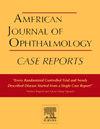Recurrence of solitary extramedullary plasmacytoma affecting both optic nerves: a case report
Q3 Medicine
引用次数: 0
Abstract
Purpose
To present a case of atypically located plasmacytoma recurrence with bilateral involvement of the optic nerves.
Observations
A 73-year-old man with diabetes, essential hypertension, and primary hypercholesterolemia presented to our clinic with subjective visual loss in his left eye. The patient had a previous history of solitary extramedullary plasmacytoma in the spinal cord, which was treated with resection surgery at the thoracic T6-T12 levels and curative radiotherapy two years prior. The ophthalmological examination indicated best-corrected visual acuity of 20/50 (0.4 logMAR) in both the right eye (OD) and left eye (OS). Intraocular pressure was normal and fundus examination of the eyes showed edema in the left optic nerve, but no other findings. Magnetic resonance imaging of the brain and orbits showed enhancement in both optic nerves, as in other parts of the central nervous system (CNS).
Conclusions and importance
Plasmacytoma represents a rare form of plasma cell neoplasm. When the condition progresses and affects different sites within the CNS, it is essential to re-evaluate and exclude progression to multiple myeloma and/or other plasma cell neoplasms. Individuals diagnosed with plasmacytoma who complain of visual disturbances should undergo ophthalmologic evaluation.
影响双侧视神经的单发髓外浆细胞瘤复发1例
目的报告一例不典型部位浆细胞瘤复发伴双侧视神经受累的病例。一名73岁男性患者,患有糖尿病、原发性高血压和原发性高胆固醇血症,左眼主观视力下降。患者既往有脊髓单纯性髓外浆细胞瘤病史,两年前在胸椎T6-T12节段行切除手术和治疗性放疗。眼科检查显示右眼(OD)和左眼(OS)最佳矫正视力均为20/50 (0.4 logMAR)。眼压正常,眼底检查显示左侧视神经水肿,其他未见。大脑和眼眶的磁共振成像显示,两种视神经都增强了,中枢神经系统(CNS)的其他部分也增强了。结论及重要性浆细胞瘤是一种罕见的浆细胞肿瘤。当病情进展并影响到中枢神经系统内的不同部位时,必须重新评估并排除进展为多发性骨髓瘤和/或其他浆细胞肿瘤。被诊断为浆细胞瘤的人如果抱怨视力障碍,应该接受眼科检查。
本文章由计算机程序翻译,如有差异,请以英文原文为准。
求助全文
约1分钟内获得全文
求助全文
来源期刊

American Journal of Ophthalmology Case Reports
Medicine-Ophthalmology
CiteScore
2.40
自引率
0.00%
发文量
513
审稿时长
16 weeks
期刊介绍:
The American Journal of Ophthalmology Case Reports is a peer-reviewed, scientific publication that welcomes the submission of original, previously unpublished case report manuscripts directed to ophthalmologists and visual science specialists. The cases shall be challenging and stimulating but shall also be presented in an educational format to engage the readers as if they are working alongside with the caring clinician scientists to manage the patients. Submissions shall be clear, concise, and well-documented reports. Brief reports and case series submissions on specific themes are also very welcome.
 求助内容:
求助内容: 应助结果提醒方式:
应助结果提醒方式:


